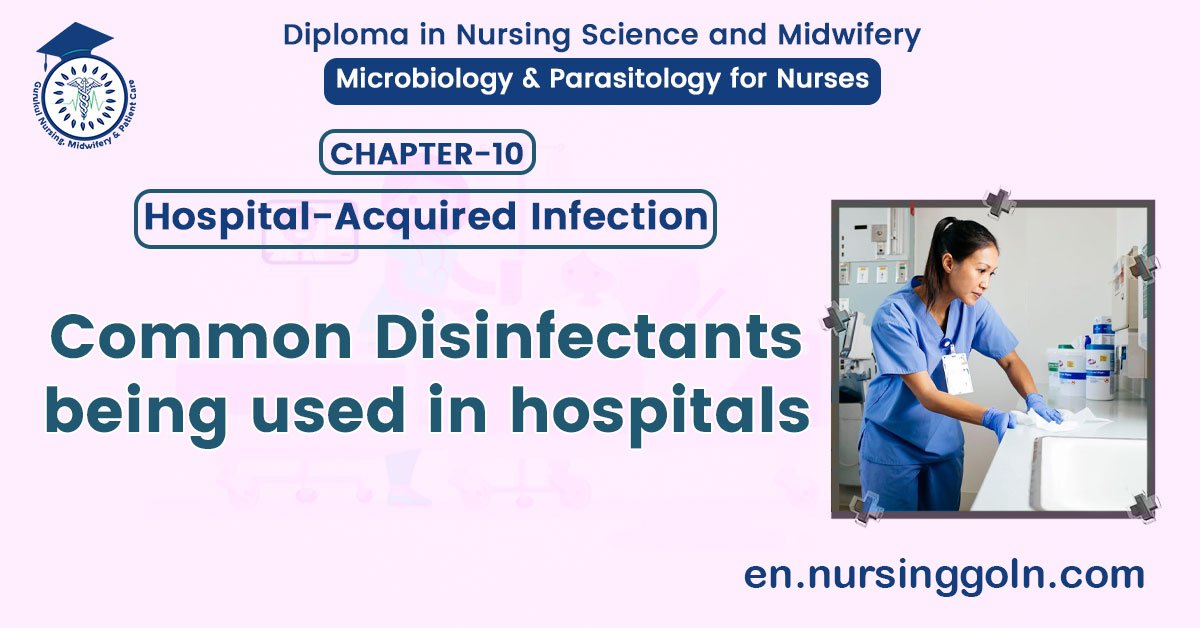Common disinfectants being used in hospitals – Basic microbiology, parasitology, and immunology; nature, reproduction, growth, and transmission of common microorganisms and parasites in Bangladesh; prevention including universal precaution and immunization, control, sterilization, and disinfection; and specimen collections and examination. Students will have an understanding of common organisms and parasites caused human diseases and acquire knowledge about the prevention and control of those organisms.
Common disinfectants being used in hospitals
Definition of Disinfectant
It is usually a chemical agent (but sometimes a physical agent) which destroys disease-causing pathogens or other harmful microorganisms, but might not kill bacterial spores.
Disinfectants are suitable for application only to inanimate objects.

Types of Disinfectant
Natural
- Sunlight
- Air
Physical
- Burning or incineration
- Hot air
- Autoclaving
- Radiation
Chemical
1. Phenol A related compounds :
- Phenol
- Crude phenol
- Cresol
- Cresol emulsion
- Chlorhexidine (Habitane).
- Hexachlorphane
- Dettol (Chloroxylenol).
2. Quaternary ammonia compounds:
- Bleaching powder.
- Na-hapochlorite.
- Halazone tab.
- Iodophores
- Iodine
3. Alcohols:
- Ethyl alcohol.
- Iso-propyl alcohol.
4. Formaldehyde.
5. Miscellaneous:
- Lime.
- Ethylene oxide
6. Gaseous disinfectant
- Formaldehyde gas
- Sulphur dioxide gas
- Cresol fumigation.
- Hydrocyanic acid gas
Qualities of Ideal Disinfectant
- It should not be very poisonous.
- It should not act on metals and should not spoil fabrics
- It should have good germicidal effect and rapid in action
- It should act powerfully in presence of organic matter
- It should not have any injurious effect on human body
- It should not have unpleasant smell
- It should act both in acid and alkaline medium
- It should not bleach or stain
- It should be readily miscible with water.
Mechanisms of Action of Disinfectants
- Disruption of the lipid-containing cell membrane (e.g. alcohol , detergent, phenol etc.).
- Modification of cellular proteins (e.g. chlorine, iodine etc.).
- Modification of nucleic acids.
- Interference with bacterial cell wall.
- Chemical antagonism.

Physical Agents of Disinfectants
- Burning or incineration.
- Hot air oven.
- Autoclaving
- Radiation
Dry heat
- Burning of articles of small value, e.g. rags, pillows and mattresses etc. This is the best Me method of disinfection.
- Hot dry air: Hot air oven is electrically heated with a thermostat and a fan & blower. The temperature & holding time 160°C for 1 hour. Dry heat is also used for sterilizing glass-wares, e.g., petridishes, pipettes, glass syringes & flasks.
Moist heat
- Boiling: At 100°C, germs & spores are killed, if boiled for half an hour.
- Steam: It can be used as
Current steam
Saturated steam
Superheated steam
- Autoclave: Here steam is used under regulated pressure (at 120°C) temperature under 15 lb/ sq. inch pressure for 15 minutes). It is used for the sterilization of culture media and destruction of old culturés. 1 also used for sterilization of surgical equipment & dressing

Radiation
- UV radiation (240-280nm wv) can he used for sterilizing air in hospital ward & operation theatre.
- UV is equally effective in gram-positive & gram-negative organisms.
- Ionizing radiation: plastic syringes, catheter, anaesthetic instrument & transfusion set can A be sterilized.
Read More….
